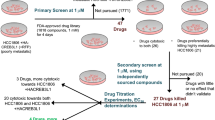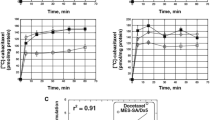Summary
We assessed the effect of the protein kinase C inhibitor 2,6-diamino-N-([1-(1-oxotridecyl)-2-piperidinyl] methyl)hexanamide (NPC 15437) on the action of anthracyclines, epipodophyllotoxins and vinca alkaloids in P-glycoprotein (Pgp)-expressing CHRC5 hamster ovary and MCF-7/AdriaR human breast cancer cells. Flow microfluorimetry revealed that treatment of CHRC5 cells with 75 μM NPC 15437 for 1 h resulted in a 6- to 10-fold increase in the nuclear accumulation of daunorubicin. Colony forming assays revealed that treatment with 75 μM NPC 15437 was associated with a 4-fold decrease in the LD90 for etoposide and a 2.5-fold decrease in the LD50 for vincristine. At higher concentrations of NPC 15437, greater modulation of anthracycline accumulation was observed; but NPC 15437 itself inhibited subsequent colony formation. Similar effects on drug accumulation and cytotoxicity were observed in MCF-7/AdriaR cells. Experiments designed to investigate the mechanism by which NPC 15437 exerts these effects revealed that treatment with the protein kinase C activator phorbol-12-myristate 12-acetate partially reversed the effect of NPC 15437, suggesting that NPC 15437 was exerting an effect through protein kinase C. Photoaffinity labeling experiments revealed that NPC 15437 also inhibited the binding of [3H]-azidopine to Pgp in isolated membrane vesicles. These results identify NPC 15437 as the prototype of a new class of potential Pgp modulators but indicate that the effects of this agent as a modulator are potentially limited by its cytotoxicity.
Similar content being viewed by others
References
Beck WT: The cell biology of multiple drug resistance. Biochem Pharmacol 36:2879, 1987
Gottesman MM, Pastan I: The multidrug transporter, a double-edged sword. J Biol Chem 263:12163, 1988
Endicott JA, Ling V: The biochemistry of P-glycoprotein mediated multidrug resistance. Annual Rev Biochem 58:137, 1989
Ford JM, Hait WN: Pharmacology of drugs that alter multidrug resistance in cancer. Pharm Rev 42:155, 1990
Cordon-Cardo C, O'Brien JP: The multidrug resistance phenotype in human cancer. In: DeVita VT Jr, Hellman S, Rosenberg SA (eds). Important Advances in Oncology. JB Lippincott, Philadelphia, 1991, pp 19–38
Fine RL, Patel J, Chabner BA: Phorbol esters induce multidrug resistance in human breast cancer cells. Proc Natl Acad Sci USA 85:582, 1988
O'Brian CA, Fan D, Ward NE, Seid C, Fidler U: Level of protein kinase C activity correlates directly with resistance to adriamycin in murine fibrosarcoma cells. FEBS Letters 246:78, 1989
Posada J, Vichi P, Tritton TR: Protein kinase C in adriamycin action and resistance in mouse sarcoma 180 cells. Cancer Res 49:6634, 1989
Posada JA, McKeegan EM, Worthington KF, Morin MJ, Jaken S, Tritton TR: Human multidrug resistant KB cells overexpress protein kinase C: Involvement in drug resistance. Cancer Commun 1:285, 1989
Chambers TC, Chalikonda I, Eilon G: Correlation of protein kinase C translocation, P-glycoprotein phosphorylation and reduced drug accumulation in multidrug resistant human KB cells. Biochem Biophys Res Commun 169:253, 1990
Ward NE, O'Brian CA: Distinct patterns of phorbol ester-induced downregulation of protein kinase C activity in adriamycin-selected multidrug resistant and parental murine fibrosarcoma cells. Cancer Letters 58:189, 1991
Gollapudi S, Patel K, Jain V, Gupta S: Protein kinase C isoforms in multidrug resistant P388/ADR cells: A possible role in daunorubicin transport. Cancer Letters 62:69, 1992
Dolci ED, Abramson R, Xuan Y, Siegfried J, Yuenger KA, Yassa DS, Tritton TR: Anomalous expression of P-glycoprotein in highly drug-resistant human KB cells. Int J Cancer 54:302, 1993
Chambers TC, McAvoy EM, Jacobs JW, Elion G: Protein kinase C phosphorylates P-glycoprotein in multidrug resistant human KB carcinoma cells. J Biol Chem 265:7679, 1990
Chambers TC, Zheng B, Kuo JF: Regulation by phorbol ester and protein kinase C inhibitors, and by a protein phosphatase inhibitor (okadaic acid), of P-glycoprotein phosphorylation and relationship to drug accumulation in multidrug-resistant human KB cells. Mol Pharmacol 41:1008, 1992
Ferguson PJ, Cheng Y-C: Transient protection of cultured human cells against antitumor agents by 12-O-tetradecanoylphorbol-13-acetate. Cancer Res 47:433, 1987
Hamada H, Hagiwara K-I, Nakajima T, Tsuruo T: Phosphorylation of the Mr 170,000 to 180,000 glycoprotein specific to multidrug-resistant tumor cells: Effects of verapamil, trifluoperazine, and phorbol esters. Cancer Res 47:2860, 1987
Dong Z, Ward NE, Fan D, Gupta KP, O'Brien CA:In vitro model for intrinsic drug resistance: Effects of protein kinase C activators on the chemosensitivity of cultured human colon cancer cells. Mol Pharmacol 39:563, 1991
Bates SE, Lee JS, Dickstein B, Spolyar M, Fojo AT: Differential modulation of P-glycoprotein transport by protein kinase inhibition. Biochemistry 32:9156, 1993
Schwartz GK, Arkin H, Holland JF, Ohnuma T: Protein kinase C activity and multidrug resistance in MOLT-3 human lymphoblastic leukemia cells resistant to trimetrexate. Cancer Res 51:55, 1991
Yu G, Ahmad S, Aquino A, Fairchild CR, Trepel JB, Ohno S, Suzuki K, Tsuruo T, Cowan KH, Glazer RI; Transfection with protein kinase Cα confers increased multidrug resistance to MCF-7 cells expressing Pglycoprotein. Cancer Comm 3:181, 1991
Fan D, Fidler U, Ward NE, Seid C, Earnest LE, Housey GM, O'Brian CA: Stable expression of a cDNA encoding rat brain protein kinase C-βI confers a multidrug-resistant phenotype on rat fibroblasts. Anticancer Res 12:661, 1992
Ahmad S, Safa AR, Glazer RI: Modulation of P-glycoprotein by protein kinase C alpha in baculovirus expression system. Biochem 33:10313, 1994
Smith CD, Zilfou JT: Circumvention of P-glycoproteinmediated multiple drug resistance by phosphorylation modulators is independent of protein kinases. J Biol Chem 270:28145, 1995
Ahmad S, Glazer RI: Expression of the antisense cDNA for protein kinase Ca attenuates resistance in doxorubicin-resistant MCF-7 breast carcinoma cells. Mol Pharmacol 42:858, 1993
Sato W, Yusa K, Naito M, Tsuruo T: Staurosporine, a potent inhibitor of C-Kinase, enhances drug accumulation in multidrug resistant cells. Biochem Biophys Res Commun 173:1252, 1990
Wakusawa S, Nakamura S, Tajima K, Miyamoto K, Hagiwara M, Hidaka H: Overcoming of vinblastine resistance by isoquinolinesulfonamide compounds in adriamycin-resistant leukemia cells. Mol Pharmacol 41:1034, 1992
Nakano H, Kobayashi E, Takahashi I, Tamaoki T, Kuquu Y, Iba H: Staurosporine inhibits tyrosine-specific protein kinase activity of rouse sarcoma virus transforming protein p60. J Antibiotics 40:706, 1986
Tamaoki T, Nomoto H, Takahashi I, Kato Y, Morimoto M, Tomita F: Staurosporine, a potent inhibitor of phospholipid/Ca++ dependent protein kinase. Biochem Biophys Res Commun 135:397, 1986
Sullivan JP, Connor JR, Tiffany C, Shearer BG, Burch RM: NPC 15437 interacts with the Cl domain of protein kinase C. FEBS Letters 285:120, 1991
Sullivan JP, Connor JR, Shearer BG, Burch RM: 2,6-Diamino-N-([1 -(1-oxotridecyl)-2-piperidinyl]methyl) hexanamide (NPC 15437): A novel inhibitor of protein kinase C interacting at the regulatory domain. Mol Pharmacol 41:38, 1992
Hendricks CB, Rowinsky EK, Grochow LB, Donehower RC, Kaufmann SH: Effect of P-glycoprotein expression on the accumulation and cytotoxicity of topotecan (SK&F 104864), a new camptothecin analogue. Cancer Res 52:2268, 1992
Kaufmann SH: Antagonism between camptothecin and topoisomerase II-directed chemotherapeutic agents in a human leukemia cell line. Cancer Res 51:1129–1136, 1991
Bech-Hansen NT, Till JE, Ling V: Pleiotropic phenotype of colchicine-resistant CHO cells: cross-resistance and collateral sensitivity. J Cell Phys 88(1):23–31, 1976
Van der Bliek AM, Van der Velde-Koerts T, Ling V, Borst P: Overexpression and amplification of five genes in a multidrug-resistant Chinese hamster ovary cell line. Mol Cell Biol:1671–1678, 1986
Fairchild CR, Ivy P, Kao-Shan C-S, Whang-Peng J, Rosen N, Israel MA, Melera PW, Cowan KH, Goldsmith ME: Isolation of amplified and overexpressed DNA sequences from adriamycin-resistant human breast cancer cells. Cancer Res 47:5141–5148, 1987
Safa AR, Glover CJ, Sewell JL, Meyers MB, Biedler JL, Felsted RL: Identification of the multidrug resistance-related membrane glycoprotein as an acceptor for calcium channel blockers. J Biol Chem 262:7884, 1987
Yang C-PH, DePinho SG, Greenberger LM, Arceci RJ, Horwitz SB: Progesterone interacts with P-glycoprotein in multidrug-resistant cells and in the endometrium of gravid uterus. J Biol Chem 264:782, 1989
Lever J: Active amino acid transport in plasma membrane vesicles from simian virus 40-transformed mouse fibroblasts. Characteristics of electrochemical Na+ gradient-stimulated uptake. J Biol Chem 252:1990, 1977
Bradford M: A rapid and sensitive method for the quantitation of microgram quantities of protein utilizing the principle of protein-dye binding. Analytical Biochem 72:248, 1976
Greenberger LM, Williams SS, Georges E, Ling V, Horwitz SB: Electrophoretic analysis of P-glycoproteins produced by mouse J774.2 and Chinese hamster ovary multidrug-resistant cells. J Natl Cancer Institute 80:506, 1988
Pearce HL, Safa AR, Bach NJ, Winter MA, Cirtain MC, Beck WT: Essential features of the P-glycoprotein pharmacophore as defined by a series of reserpine analogs that modulate multidrug resistance. Proc Natl Acad Sci USA 86:5128, 1989
D'Incalci M: DNA-topoisomerase inhibitors. Current Opinion in Oncology 5(6);1023–1028, 1993
Chen AY, Liu LF:DNA topoisomerases: essential enzymes and lethal targets. Annu Rev Pharmacol Toxicol 34:191–218, 1994
Pommier Y, Leteurtre F, Fesen MR, Fujimori A, Bertrand R, Solary E, Kohlhagen G, Kohn KW: Cellular determinants of sensitivity and resistance to DNA topoisomerase inhibitors. Cancer Investigation 12(5):530–542, 1994
Sahyoun NE, Wolf M, Besterman J, Hsieh T-S, Sander M, Le Vine H, Chang K-J, Cuatrecases P: Protein kinase C phosphorylates topoisomerase II: topoisomerase activation and its possible role in phorbol ester-induced differentiation of HL-60 cells. Proc Natl Acad Sci USA 83:1603–1607, 1986
Nishizuka Y: Intracellular signaling by hydrolysis of phospholipids and activation of protein kinase C. Science 258:607, 1992
Author information
Authors and Affiliations
Rights and permissions
About this article
Cite this article
Sha, E.C., Sha, M.C. & Kaufmann, S.H. Evaluation of 2,6-Diamino-N-([1-(1-oxotridecyl)-2-piperidinyl]methyl) hexanamide (NPC 15437), a protein kinase C inhibitor, as a modulator of P-glycoprotein-mediated resistancein vitro . Invest New Drugs 13, 285–294 (1995). https://doi.org/10.1007/BF00873134
Issue Date:
DOI: https://doi.org/10.1007/BF00873134




